Survival kits have one major purpose: to help you survive in the event of a natural disaster, financial crisis, or war. Most of us buy a survival kit with the hope that we’ll never actually need it, but as the saying goes, “It’s better to have it and not need it than to need it and not have it.”
A good survival kit is more than just useful in the direst of situations. “Survival” can sometimes mean alleviating pain from blisters on a long hike or repairing a tear in your backpack or tent.
Survival kits are useful in a variety of scenarios, but determining which is best for you can be a daunting task.
That’s why we’ve created our list of the 10 Best Survival Kits to help simplify your decision.
1. The Seventy2 Survival System
The Seventy2 Survival System(As seen on Shark Tank!) is unique in that it was specifically designed and curated by survival experts. The comprehensive survival system not only includes a number of handy tools but it also offers detailed survival instructions for a number of emergency situations. The Seventy2 Survival System is an incredible pack and has been given high praise from TIME, Outside Magazine, Huffington Post, Field and Stream, and dozens of other critics. They rave over the design, quality and ease of use in survival situations.
Widely regarded as “the world’s best 72-hour Survival Kit,” this system features an external shell made of 600-Denier Tarpaulin material, a Sawyer Water Filtration system, a Mylar Thermal survival tent, a 20-piece first aid kit, 100 feet of paracord, lightweight goggles, a survival knife, and much more! If you don’t ever want to buy another survival kit again, grab this one now.
2. The Complete Earthquake Bag – Emergency kit for Earthquakes, Hurricanes, floods + Other disasters
This Complete Earthquake Kit is a # 1 Best Seller on Amazon! The kit is perfect in case of emergencies, specifically earthquakes, hurricanes, and floods.
The kit is smartly-packed with: food and water, first aid, hygiene kits baby supplies, shelter, warmth, tools, and off-the-grid light and communication.
It also includes sleeping bags, tents, hand and body warmers, safety Goggles, Sewing Kit, and Leather Palm Gloves. This kit contains everything you would need to survival a natural disaster for multiple days.
3.1-Month (30-Day) Emergency Food Kit – Emergency Essentials
The Emergency Essentials 30-Day 1-Person Emergency Food Kit is a high-quality survival product designed to provide essential sustenance during emergency situations. This kit, which meets Quality Survival Standards (QSS) certification, offers a comprehensive selection of long-lasting, nutritious food items to support an individual for 30 days.
It includes a variety of non-perishable options, such as freeze-dried meals, canned goods, and energy bars, ensuring a balanced diet even in challenging circumstances. With a focus on convenience and shelf life, this food kit is an excellent choice for emergency preparedness and peace of mind.
4. Emergency Zone Family Prep 72 Hour Survival Kit/Go-Bag
The Emergency Zone 72-Hour Disaster Survival Kit available on Amazon is a comprehensive and practical kit designed to provide essential supplies for surviving a disaster or emergency situation. This kit is specifically designed to support individuals and families for up to 72 hours. It includes a range of essential items such as emergency food and water, a first aid kit, a multi-tool, a flashlight, a radio, emergency blankets, hygiene supplies, and more.
The kit is compact, lightweight, and organized in a durable backpack for easy transportation and accessibility. With its focus on readiness and functionality, this kit is an excellent choice for emergency preparedness and ensuring your safety in unforeseen events.
5. Blue Coolers Blue Seventy-Two Emergency Backpack
The Blue Coolers Seventy-Two Hour Emergency Kit, available on Amazon, is a comprehensive and reliable survival kit designed to provide essential supplies for a 72-hour emergency period. This kit offers a range of high-quality items to support individuals and families during disasters or emergencies. It includes emergency food and water, a first aid kit, a flashlight, a radio, emergency blankets, hygiene supplies, and additional tools and accessories.
The kit is packed in a durable and portable cooler bag, ensuring that your supplies remain fresh and easily transportable. With its emphasis on quality and convenience, this emergency kit is an excellent choice for preparedness and peace of mind in uncertain situations.
6. The Mayday Earthquake Kit
The Mayday Earthquake Kit, also known as the 2-person 72-Hour Emergency Honey Bucket, is the premier earthquake-readiness survival kit on the market. It’s the perfect kit to store in your home, especially if you live in an earthquake-prone region.
This kit contains a 12-hour light stick, 54-piece first aid kit, three packs of water, 2400 calorie food bars, waterproof matches, water purification tablets, a gas & water shut off tool, utility knife, ponchos and dust masks, a roll of duct tape, a 15-inch pry bar, T-5 chemical disinfectant, and much more!
7. Ready America 70280 Emergency Kit, 2-Person, 3-Day Backpack
The first 72 hours after a disaster are critical and it is important to be prepared.
Ready America has developed a 2 Person, 3 Day Emergency Kit with the essentials two people would need for 3 days. In it you will find the basic essentials to help you and one other person get through any emergency.
The kit includes food, water, emergency blankets extra clothing, first aid kit, and other essential items.
8. EVERLIT Complete 72 Hours Earthquake Bug Out Bag
The EVERLIT Earthquake Emergency Kit available on Amazon is a comprehensive survival kit designed for handling various emergency situations. This kit is suitable for home use and provides essential supplies and tools to help individuals and families during earthquakes, hurricanes, and other disasters.
The kit includes items such as emergency food and water, a hand-crank radio, a multi-tool, a first aid kit, a flashlight, glow sticks, a survival whistle, a thermal blanket, and more. With a focus on durability and practicality, this kit is a reliable option for emergency preparedness and ensuring safety in challenging circumstances.
—
Buyer’s Guide
What Should Be In My Survival Kit?
When it comes to preparing for unexpected emergencies, having a comprehensive survival kit is crucial. Whether you’re venturing into the great outdoors, bracing for natural disasters, or simply seeking peace of mind, the best survival kit should provide you with the essentials to survive and thrive in challenging circumstances. This summary presents an overview of the components that make up the ultimate survival kit.
- Shelter and Warmth: A durable and lightweight tent or emergency shelter is essential for protection against harsh weather conditions. Additionally, a sleeping bag designed for extreme temperatures, emergency blankets, and a fire-starting kit should be included to ensure warmth and comfort.
- Water and Food: Clean drinking water is a top priority in any survival situation. Water purification tablets or filters, collapsible water containers, and a durable water bottle should be part of your kit. Non-perishable food items, such as energy bars, canned goods, and freeze-dried meals, are excellent options for sustenance.
- First Aid: A comprehensive first aid kit is vital for handling injuries and medical emergencies. It should include bandages, antiseptic wipes, adhesive tape, pain relievers, a thermometer, tweezers, and other essential medical supplies. Don’t forget to include any necessary personal medications or prescriptions.
- Tools and Navigation: A reliable multi-tool with various functionalities, such as a knife, pliers, screwdrivers, and a can opener, is indispensable. A compass, map, whistle, flashlight, extra batteries, and a signal mirror are crucial for navigation, communication, and attracting attention if needed.
- Communication and Power: In the digital age, staying connected is vital. Include a battery-powered or hand-crank radio for receiving emergency broadcasts, as well as a power bank to charge your electronic devices. Additionally, a portable solar charger can harness renewable energy in case of extended power outages.
- Personal Protection: Ensure personal safety by including items like a sturdy knife, pepper spray, a whistle, and a small self-defense tool. These can be valuable in unexpected encounters or dangerous situations.
- Clothing and Hygiene: Pack appropriate clothing for different weather conditions, including thermal layers, waterproof outerwear, sturdy boots, hats, and gloves. Include hygiene items such as soap, toilet paper, wet wipes, and hand sanitizer to maintain cleanliness and prevent the spread of diseases.
- Miscellaneous Items: Consider additional items that can greatly enhance your survival experience, such as a waterproof notepad and pen, a sewing kit, duct tape, paracord, a portable stove, utensils, extra cash, and a small sewing kit.
The first 72 hours after a disaster strikes or after you realize you’re lost is critical (3). After Hurricane Sandy, for example, more than 8.1 million homes were without power. The hurricane made landfall in late October and some New Jersey residents were still without power the night before Thanksgiving.
In terms of wilderness survival, the most common causes for Search and Rescue (SAR) Operations are fatigue and physical conditions, errors in judgment, and insufficient equipment, clothing, or experience (4). The right survival kit can eliminate at least one of these variables.
Keeping a survival kit on hand is essential whether it’s in your home, car, or stowed safely in the bottom of dry bag or your backpack. Deciding on the right kit for you will depend on a number of factors but in this buyer’s guide we’ll focus on these three characteristics: size, primary use, and cost.
Size
Survival kits come in a wide range of sizes. The smallest kits can fit under the back seat of your car and the largest take up an entire duffel bag. The most common household kits are either backpack of duffel-sized and the smallest survival kits can fit in the upper pocket of a backpacking pack.
The size that’s right for you will largely depend on where you plan to store it and how many people you want it to supply. There are survival kits designed to provide enough supplies for anywhere from one gallon for 2 to 100 people (5) for up to 72 hours.
You’ll need to be mindful of the number of people your survival kit will provide for in case of emergency. But you’ll also need to decide where you hope to store it and understand how much space your ideal kit will take up.
Primary Use
What area do you live in and what are the primary threats to that area? Are you embarking on an expedition where an extended survival situation is a real possibility?
Certain survival kits are designed primarily for when your car breaks down miles from the nearest service station. Others are designed to provide 72-hours of emergency supplies, in the event of a prolonged power outage and a delayed response by emergency services.
If your primary use would be in the event of a natural disaster, for example, you’ll need a kit that contains at least 72 hours of supplies for every member of your family. Some people also keep a gas mask in their 72 hour kit in the event of a chemical attack. But if you’re concerned about defending yourself against a horde of flesh-hungry humanoids, the Gerber Zombie Apocalypse Kit is right up your alley.
Selecting the right kit requires an understanding of the situations you’re most likely to need it for. A helpful exercise can be to create a list of 10 items you’d absolutely need in the event of a natural disaster or extended period without power and access to food and water. Then make a list of another 20 to 3o supplies you’d also like to have handy in this situation. Another item to consider adding to your survival kit are MRE’s. This will give you a basic first aid supplies and great baseline to help you narrow down your options.
Cost
The cost of other survival kits will likely be the deciding factor in your decision. Some of the most extensive survival kits on the market today can cost upwards of $2,000. This might not be the perfect kit for you, but it’s also important not to cut corners when it comes to your survival.
There are a number of risks you’ll be exposed to through a lack of emergency preparedness, including dehydration, starvation, and death from a common illness (6). There is no reason why you and your other family members should be exposed to these risks through a lack of preparation.
A well-stocked survival kit significantly increases well-being and comfort in the most physiologically challenging of situations. The kits we’ve outlined above range from $30 to $350. We recommend finding an option that fits your budget but also gives you the range of supplies you’ll need in an emergency situation.
Frequently Asked Questions
The right survival kit can mean the difference between life and death. But you’ll need as much information as possible to select the right kit for you. To that end, we’ve put together a brief summary of the most frequently asked questions about survival kits.
Where should I keep my survival kit?
We recommend you store your survival kit in a cool, dry place. This will allow you to maximize the shelf life of the perishable goods contained in some or most survival kits, i.e. food and water.
Your kit should be easily accessible at a moment’s notice. This means choosing a storage space in the most frequented areas of your house. Typically, the kitchen, living room, or mudroom closets are great options. Many people store kits in their garage as well, but in the event of an unpredicted flood, your kit can wind up waterlogged before you know it.
What is most important to my survival?
While you might find certain items in your survival kit more useful than others, this will largely depend on the exact nature of your emergency. Generally, food and water are going to be the most vital items when facing any prolonged disaster. After that, items like Mylar blankets and tube tents provide shelter from the elements and fire starters can help you provide critical warmth and ability to cook food or boil water. Some people like to include a folding saw or an ax.
What do people mean when they refer to ‘SHTF’?
SHTF commonly stands for when “stuff hits the fan.” In other words, when things go wrong and your best-laid plans must be scrapped. In this case, it’s more critical than ever that you have a plan for survival and a kit that helps you execute it.
Summary
Survival kits have come a long way since Johnson & Johnson first started developing commercial first aid kits in 1888 (7). Today’s kits are often crafted by survival experts and tailored to provide critical first aid supplies in the event of a major natural or man-made disaster.
We hope that you’ve found a great deal of useful information above and that you find the survival kit that’s best for your needs. As we mentioned at the start, it’s not a matter of if you’ll need it. It’s a matter of when it winds up saving the day!

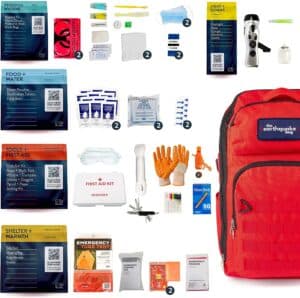
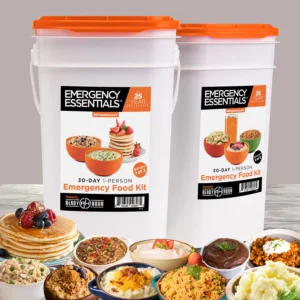

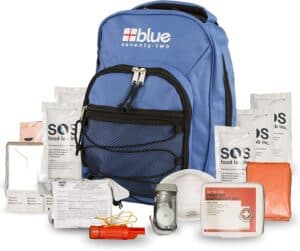
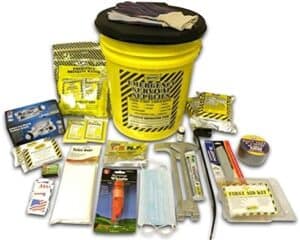

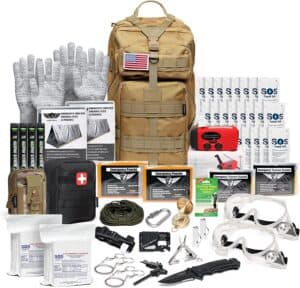

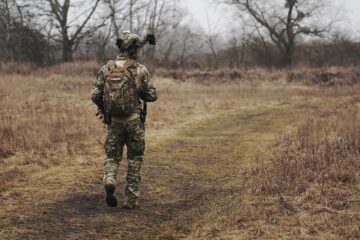

1 Comment
Ranking the 10 Best Tactical Flashlights of 2018 · April 10, 2018 at 10:44 pm
[…] What is a Tactical Flashlight used for? There are many different uses for tactical flashlights. A lot of people consider a tactical flashlight a crucial item in their bug out bag checklist. Tactical flashlights can also be used for self defense, since they are bright, made out of sturdy metal, and some have bezel edges. Many people carry them in emergency car kits and 72 hour kits. […]
Comments are closed.